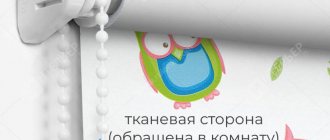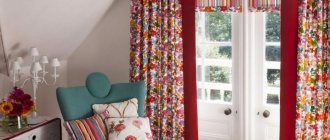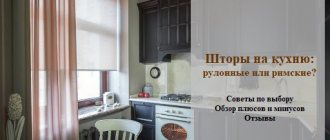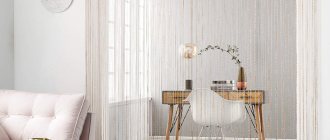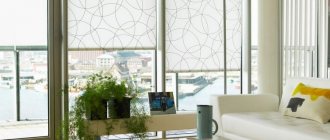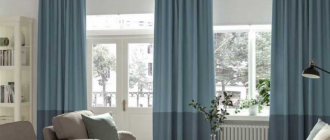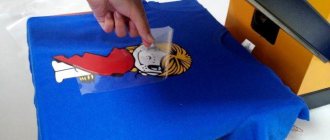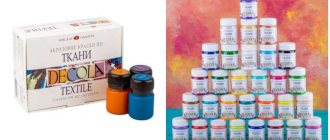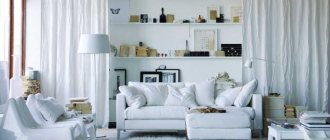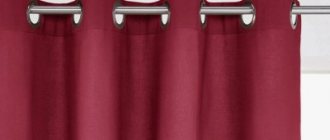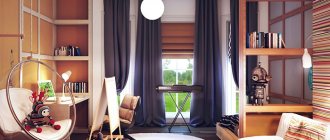It’s hard to imagine a country house without an open terrace or gazebo. For all family members, this is a favorite place to spend leisure time in the summer heat.
It’s unlikely that anyone will refuse to relax on a hot afternoon under the arches of the roof, protecting from the bright sun and summer rains. In the evenings and in cool weather, you can hide here from the wind and insects without resorting to glazing the room. Protective curtains for gazebos and verandas will help with this. By choosing appropriate curtain models, you can create a comfortable interior for meetings with friends and family.
Features of outdoor curtains
Outdoor curtains are made from practical fabrics and special materials. Thanks to their water-repellent properties, they will provide protection from rain and bad weather in an open area.
What are they for?
The importance of curtains in the design of a veranda or gazebo in a country house can hardly be overestimated. In addition to their practical functions, properly selected curtains add attractiveness and completeness to the building.
Curtains in the interior of an open terrace solve a number of problems:
- serve as excellent decor;
- emphasize the individuality of the room;
- cover from sunlight, wind and rain;
- retain heat inside the building;
- protect against insect invasion;
- protect vacationers from prying eyes;
- hide mistakes made during construction.
Requirements for curtain material
Depending on the functional load placed on the curtains, various fabrics, thick tarpaulins or blinds are used for production.
The material is selected taking into account the following parameters:
- wear resistance;
- waterproof;
- fire resistance;
- ease of care;
- resistance to fading.
Fabric that meets all the characteristics is not cheap, but these costs are completely justified. Curtains made from “smart” material will last up to 5 seasons, and with proper care, even longer. Regular curtains made of curtain or raincoat fabric on the terrace will last 1-2 seasons.
Dimensions
The main parameters of the canvas are height and width, which depend on the size of the cornice and the thickness of the material. To create the ideal volume, the curtain, as a rule, should be one and a half to two times wider than the cornice.
The length of the curtain can be of 4 types:
- To the windowsill. It is used for windows located in niches with a horizontal direction. The curtains only lightly touch the window sill.
- Average. With this option, the curtain hangs just below the railing, not reaching the level of the radiators (if any). Canvases of this length can be secured with pendants. With the curtains pulled apart, the windows will look very attractive.
- To the floor. Windows of unusual shape, arched or French style look best if decorated with such models. Freely falling to the floor, they will decorate the spacious veranda. By adding 10-15 cm on top and up to 50 cm of fabric on the bottom, you can get very long curtains that lie on the floor in spectacular flounces.
- Cafe style. These are small canvases that cover the lower part of the window and leave the upper part open. In this case, air and light rays freely penetrate into the room, and resting people are not visible from the street.
Rafblinds
Rafblinds are metal or wooden blinds that are attached to the outside of a gazebo or veranda. A gazebo with rainblinds will be reliably protected from bright sunlight. Also, such curtains provide good sound insulation. The edges of each strip on such blinds are made rounded, this is necessary so that during rain water does not accumulate on the curtains, but flows down. Metal blinds are made of stainless steel, and wooden ones are impregnated with a special moisture-resistant composition.
Types of curtains for verandas and gazebos by design features
Taking into account the characteristics of the material used and the style of construction, you can choose the best option for curtains and create comfort in the gazebo or on the terrace.
Fabric
Fabric curtains create a special atmosphere that promotes relaxation and rest. They protect from bright sun and do not interfere with free air circulation. Used for glazed and open structures.
Advantages of fabric curtains:
- radically transform the interior;
- able to change mood;
- bring life to the simplest room;
- have an affordable price and a wide palette of shades.
It is better to treat outdoor curtains with a special water-based product to repel ticks and insects. The procedure must be repeated after each wash.
Disadvantages of outdoor use:
- short service life;
- rapid burnout;
- loss of strength.
Roller blinds
An alternative to fabric models and heavy curtains are roller blinds.
The design principle is quite simple:
- the fabric is wound on a shaft hidden in a box;
- mounted above the window opening or on the frame.
Opening and closing is done manually or automatically (electric drive and remote control). The system operates almost silently.
Roller blinds for gazebos can be outdoor (reflexol) or indoor. To manufacture the first type, polyester impregnated with polyvinyl chloride is usually used as a material. They are often made from translucent material.
Advantages of the canvas:
- allows diffused light into the room;
- creates shadow;
- protects the room from the wind.
At the same time, you still have the opportunity to enjoy the view from the window.
Features of roller blinds:
- large selection of color palettes;
- fits perfectly into any interior;
- do not take up much space;
- convenient to use.
Blinds
Blinds for open spaces differ from those for offices. Almost all models allow you to adjust the level of illumination in the room.
The main advantages of their installation:
- contribute to the reflection of heat and bright light;
- prevent overheating of the room;
- protect from wind and precipitation;
- muffles street noise;
- serve well at temperatures from -40 °C to +50 °C;
- have increased resistance to deformation and corrosion;
- have a service life of 10 years.
A variety of design solutions and shades allows you to use blinds in any interior.
For street buildings, 2 types of structures are used:
- Classic. The most widespread are horizontal blinds made of aluminum. The “wood” style looks great in a gazebo and is combined with wooden buildings made of logs and timber. They are relatively cheap.
- Wooden. Models with natural wood slats look noble. Suitable for any interior and create an atmosphere of unity with nature. Compared to aluminum, this is a more expensive option.
Wooden structures are more resistant to drafts, as they have more weight.
Rafblinds
Rafblinds are sun protection systems that allow you to regulate the amount of incoming light and provide additional sound insulation.
Design features:
- made from aluminum or stainless steel;
- have curved edges of the strips, adding rigidity;
- installed outside the gazebo;
- opening and closing is smooth and silent;
- operate in manual or automatic mode.
Manufacturers offer models with light, rain and wind sensors. It is even possible to combine it with a smart home system.
Video description
The video talks about soft window systems:
There are systems on the market called Black Out. They are made from fabrics and materials that completely do not transmit daylight and prevent it from penetrating into the gazebo space.
Thick fabrics for sun protection Source i.ebayimg.com
Types of curtains by material of manufacture
Curtains in the gazebo are a bright element of the interior and attract attention.
Based on the material used, products can be divided into several types:
- fabric;
- protective and PVC fabrics;
- from natural materials;
- artificial.
Having studied the features of each of them, it is easy to choose an option that meets all the expectations of the owner of the gazebo.
Fabric sheets
The material for curtains on the veranda is selected depending on the time of year. For the summer heat, light and transparent types of fabrics are relevant.
Most in demand for the summer season:
- cotton;
- organza;
- tulle;
- silk;
- linen;
- flannel.
Light textile curtains provide almost no protection from wind and bad weather. They are mainly used for glazed gazebos and terraces. Fabric curtains for an open veranda do not interfere with air circulation and protect from sunlight as well as others.
Models made of airy silk, organza or chiffon will create a romantic atmosphere in the building. Curtains made of dense natural fabrics are suitable for lovers of eco-style. Linen and canvas look great as Roman patterns.
Protective and transparent PVC
You want to relax in comfort in the open air not only on sunny days, but also in bad weather. Protective curtains are more suitable for this time.
Curtains made of polyvinyl chloride have a number of features:
- wear resistance and strength;
- used for industrial and domestic purposes;
- made of transparent or thick film;
- They can be combined or only with edging.
PVC products are widely used in everyday life.
The fabric has good performance properties:
- long service life;
- resistance to adverse weather conditions and temperature changes;
- fire resistance;
- ability to resist pollution;
- moisture resistance;
- non-susceptibility to deformation.
Plastic curtains are popular among owners of dachas and country houses. Any open structure can be closed with such material.
Premises where the products are used:
- warehouse and production;
- cafes and restaurants;
- verandas, gazebos and open terraces.
In the interior of the house - living rooms, kitchen and hallway - such curtains are not used.
Depending on the place of use:
- frost-resistant;
- heat-saving;
- increased strength;
- standard soft curtains.
Compared to conventional glazing, the use of film has its advantages.
Advantages of the material:
- safety - the window is not easy to break;
- transparency - allows you to admire the landscape;
- quick installation and disassembly.
PVC products have an attractive design and do not have a harmful effect on humans. When choosing them, protection from bad weather, insects and animals will be provided.
The disadvantages of polymer curtains are:
- tendency to retain moisture;
- heat accumulation as the temperature rises.
In the summer, in a gazebo, the walls of which are made of PVC fabric, people will feel like they are in a greenhouse. There is no need to install barbecues or heaters here.
Bamboo
Curtains made of natural material with unusual weaving will give your terrace or gazebo an exclusive appearance. In the interior of wooden premises, such models look very impressive. They can be the best option when decorating an open or closed veranda.
Benefits of bamboo:
- wear resistance;
- environmental friendliness;
- durability;
- easy to clean and wash;
- does not cause allergies;
- does not accumulate electricity;
- does not allow insects to pass through.
The products are quite expensive. The bamboo sheet is easily rolled up over a window or doorway, so it does not take up much space and does not interfere with movement.
The strengths of the material are its warm natural tone and original design. In combination with wicker furniture made from wicker, the curtains look harmonious, and the greenery of the garden looks like a bright spot against their background.
Rolled structures made of natural materials and bamboo are gaining popularity. They are versatile, easy to assemble and straighten.
Acrylic
Of the synthetic fabrics, acrylic is the most widely used.
Advantages of using the material:
- good moisture-repellent properties;
- density about 280 g/m2;
- high strength;
- ability to diffuse solar rays.
It has only one drawback: rigidity. Storing curtains folded leads to the formation of folds and microcracks at the folds.
Acrylic curtains have several varieties. The most modern ones include blackout - a multi-layer fabric that looks no different from ordinary curtains. It creates a barrier to water and sun and is characterized by high sound insulation properties.
Lightproof material, developed in Finland, is able to retain warmth and silence, creating intimate twilight in the gazebo. Blackout does not burn; in the event of a fire, it melts, releasing a minimum of harmful substances.
Consists of two or three layers:
- The outer one, facing the street, is a canvas containing the finest metal threads that reflect light.
- The inner one is a dark, tightly woven sun protection material with acrylic impregnation that repels moisture.
- The third does not always happen. This is a decorative fabric imitating satin, silk or jacquard with an ornament.
Three-layer blackout is expensive. Curtains made from it look great in any design.
Thick fabrics
Heavy fabrics will help to more reliably protect from the sun and rain, maintain privacy, and create shade.
They can be designed in the form of Roman or Austrian curtains, classical or Scandinavian, Japanese or stained glass curtains.
Loose fabrics blowing in a light wind are perfect for the Mediterranean style.
Criterias of choice
The choice of curtain type depends on the tasks assigned to them and the characteristics of the room.
There are a number of requirements for outdoor curtains for gazebos and verandas:
- Strength. The fabric needs to be able to withstand strong winds.
- Resistant to moisture. Curtains in the gazebo protect the room from any precipitation.
- Combination with other interior elements. Curtains must be in harmony with the architecture of the building and fit into the design of the site on which the building is located.
- Color palette. For open spaces, it is better to choose curtains in natural tones. Light-colored models do not weigh down the building and do not overload the space. You can add bright details using canvases with contrasting patterns.
Terrace design options
Models of the simplest configuration fit harmoniously into the overall exterior, decorate it with their appearance and perfectly perform practical functions.
The photo shows a terrace with bright outdoor curtains.
Mounting methods
The method of attaching curtains depends on the material of manufacture and the features of the building. You can hang products using various devices.
Fastening structures include:
- Cornices in one or several rows. They support the weight of the canvas and allow it to be moved along the opening. They are flat or round, of different diameters. Equipped with rings and cords for opening curtains. Cornices can be brass, iron or wood.
- The brackets are rotating and with belts. They are held in place by outdoor curtains fixed around the perimeter of the gazebo. This type of fastening is not afraid of blizzards and wind. Curtains can be rolled up on a strap, closed and opened.
- Various roll mechanisms.
The system with rotary brackets is considered the most reliable. Staples are inserted through the eyelets along the perimeter of the canvas, which allows you to unfold and roll the curtains into a roll. When the staple is turned, the fabric is fixed in an unfolded form, and the fabric is stretched.
Open spaces are constantly exposed to aggressive environments. To attach curtains, it is necessary to choose guides made of materials that are not susceptible to oxidation.
How to make curtains from burlap with your own hands
Burlap is a coarse fabric made of interwoven thick fibers. The material is often used for needlework, room decoration and creating modern interiors.
Advantages of burlap curtains:
- naturalness and environmental friendliness;
- calm practical color;
- long service life;
- cheapness;
- versatility.
Curtains look great in a wooden gazebo and on the terrace. This simple fabric is highly valued by designers.
The following raw materials are used for its production:
- jute;
- linen;
- kenaf;
- cable car;
- hemp.
To make curtains with your own hands you need a sewing machine and half an hour of time. The fabric tends to shrink, so it needs to be washed and ironed before use.
The manufacturing steps are as follows: Determine the length and add 16 cm to the hem.
Cut a piece of burlap to the specified length.
Fold the top edge over twice, press and stitch the seam. Process the bottom edge in the same way.
A combination with bright chintz, white lace and braid will help radically change the interior. With a little effort and creativity you can create original burlap designs.
These curtains are best suited for interiors in the style of:
- Provence;
- country;
- eco.
A video will help you make fabric curtains with your own hands.
Style directions
There are many styles in which curtains for gazebos are decorated:
- country;
- Roman;
- roll;
- roller blinds;
- thread;
- sliding
The rustic country style will delight you with its bright patterns and cheerful mood.
Cheerful pink flowers on the curtains along with a transparent veil give lightness to the interior, which complements furniture with bright pillows and vases of flowers. The large veranda windows let in a lot of light
Fashionable and laconic Roman blinds provide good protection from the sun.
Bright and colorful Roman curtains fold into neat folds using a simple mechanism. When necessary, close the terrace windows tightly and protect it from sunlight.
A practical option is roller blinds for the terrace; they have another name – fabric roller blinds. The roll is opened automatically by remote control or manually. Acrylic fabric or blackout is often used. Roller blinds have the same design principle; they are mounted indoors, and roller blinds are mounted outside.
Acrylic fabric, which diffuses light, creates a pleasant aura indoors, repels moisture, and is resistant to gusts of wind. Caring for rolled sheets is simple - they are wiped off dust with a damp cloth
There are fans of thread curtains - fabric strands on a common basis. They can be made from natural jute threads, fishing line, plastic, wire. They often serve as an element of terrace decor; they do not absorb the sun's rays.
To a terrace with bright decor, light thread curtains add sophistication. The threads are of different lengths, in several places they were given an arched shape. They scatter sunlight slightly. Performs a decorative function perfectly
For verandas, sliding panels with a rigid frame in the Japanese style are often chosen; they are attached to the eaves.
The movement of the stretched fabric panels of the sliding panels for the terrace is directed along the windows. The panels can be easily moved in different directions; each has its own guide. They block access to sunlight and are easy to care for.
A beautiful combination of white roller blinds and light curtains with a floral pattern and a striped lambrequin on a veranda decorated in Provence style. The predominant warm beige shade in the interior in harmony with the pink colors of the curtains
Making your own PVC curtains
You can make transparent PVC curtains for verandas and gazebos with your own hands.
To work you need to prepare:
- PVC film 0.5–0.7 mm thick;
- soft colored PVC fabric;
- eyelets, twine, staples;
- tools: scissors, tape measure, hammer, ruler or wooden block.
Pattern
If the width of the film is not sufficient, it is necessary to solder the two parts overlapping. In this case, for each part you need to add 20 mm per seam.
Cutting out the product is quite simple:
- First you need to measure the openings, capturing the support pillars.
- Cut strips 10–12 cm wide from colored fabric, this will be the edging.
- Roll out the transparent film.
- Cut out the required number of parts, adding 5 cm to the folds.
Spike
For soldering, use a thermal roller or a regular soldering iron, which should be slightly upgraded. For brackets, two parts about 1 mm thick are made from sheet iron or a tin can. Holes for connection are drilled on both sides at the ends.
For the roller, you can use a steel washer with a diameter of 18-22 mm. Use a file or sandpaper to smooth the edges and working surface of the roller, sanding everything smooth. Contacting parts are rubbed with graphite powder. The structure is assembled using two bolts and washers.
Before use, the soldering iron must be tested on an unnecessary piece of film. The temperature should be appropriate, but not burn through the material.
The process goes like this:
- First, colored blanks are laid out on a heat-resistant surface, and transparent ones on top.
- The colored strips are folded in half, wrapping the transparent parts around the perimeter. You need to “sew” them together.
- The film layers are fixed with a metal ruler (wooden strip) and the weld line is determined, drawn with a thermal roller along the ruler - the seam is ready.
You can avoid parts moving during soldering by using clamps or weights. Scotch tape is also suitable if you use it to glue the part to the surface.
Fittings and installation
Eyelets are installed around the perimeter of the curtain every 15–20 cm. To do this, holes of the appropriate diameter are made using a punch. The package usually contains a special tool that can be used to do them. If you don't have a punch, you can use scissors, but this is very difficult. The reliability of the fastening depends on the accuracy of the cut hole.
A part of the eyelet with a high neck is inserted into the hole from below, and a thin one is put on top. The part is connected by hitting the hammer at a right angle.
The installation is shown in detail in this video.
You can also secure plastic curtains using:
- swivel brackets;
- rope (strap), passing it through the staples.
